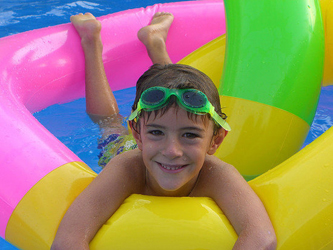 |
|
|
|
 |
|
Pool & Spa Safety
For millions of Americans, swimming pools and spas are great places for families to spend time together and have fun. Yet it's important to ensure everyone stays safe in and around pools and spas.
To improve pool and spa safety, the U.S. Consumer Product Safety Commission (CPSC) launched Pool Safely: Simple Steps to Save Lives, a national public education campaign to reduce childhood drownings, submersion injuries and entrapments.
The campaign is a call-to-action for consumers and industry to adopt proven water safety steps and join a national conversation about pool and spa safety by sharing best practices and other life-saving information.
The Pool Safely campaign carries out the provisions of the Virginia Graeme Baker Pool & Spa Safety Act (P&SS Act), federal legislation mandating new requirements for public pools and spas, including a public information campaign.
To pool safely means adopting critical water safety steps to assure that a great afternoon at the pool doesn't turn into a tragic one. Whether at a residential or public pool or spa, everyone can always take additional steps to be safe while having fun.
Parents and families can build on their current safety systems at pools and spas by adopting additional water safety steps. Adding as many proven water safety steps as possible is the best way to assure a safe and fun experience, because you can never know which one might save a child's life-until it does.
Simple Steps Save Lives
Learn how simple safety steps save lives in and around pools and spas.
Staying Close, Being Alert and Watching Children in and Around the Pool
- Never leave a child unattended in a pool or spa and always watch your child when he or she is in or near water
- Teach children basic water safety tips
- Keep children away from pool drains, pipes and other openings to avoid entrapments
- Have a telephone close by when you or your family is using a pool or spa
- If a child is missing, look for him or her in the pool or spa first
- Share safety instructions with family, friends and neighbors
Learning and Practicing Water Safety Skills
- Learn how to swim and teach your child how to swim
- Learn to perform CPR on children and adults, and update those skills regularly
- Understand the basics of life-saving so that you can assist in a pool emergency

Having the Appropriate Equipment for Your Pool or Spa
- Install a four-foot or taller fence around the pool and spa and use self-closing and self-latching gates; ask your neighbors to do the same at their pools.
- Install and use a lockable safety cover on your spa.
- If your house serves as a fourth side of a fence around a pool, install door alarms and always use them. For additional protection, install window guards on windows facing pools or spas.
- Install pool and gate alarms to alert you when children go near the water
- Ensure any pool and spa you use has compliant drain covers, and ask your pool service provider if you do not know
- Maintain pool and spa covers in good working order
- Consider using a surface wave or underwater alarm
Create a Pool Safety Tookit for Your Home Pool or Spa
Drownings are a preventable cause of death and injury for children. By putting proven safety behaviors and systems into practice, you and your family will be much more secure in and around public and residential pools.
CPSC recommends that you create a pool safety toolkit to have near your pool or spa to ensure that if the worst happens, you are ready to respond.
What should be in a pool safety toolkit for your home pool or spa?
- A first aid kit
- A pair of scissors to cut hair, clothing or a pool cover, if needed
- A charged portable telephone to call 911
- A flotation device
How Safe is Your Residential Pool or Spa?
CPSC recommends that residential pool and spa owners adopt water safety steps to prevent children from accessing the water when there is no adult supervision, and they are appropriately protected when an adult is available to supervise.
By asking and answering these critical questions, you can gauge the effectiveness of your water safety measures, and determine what steps need to be taken to protect children from drowning and submersion injuries:
- Is there a fence around the perimeter of your pool or spa?
- Are there self-closing and self-latching gates?
- Are there door, gate or pool alarms in use?
- Does your pool have anti-entrapment drain covers that are compliant with the P&SS Act?
- Are all pool and spa covers in working order?
- Has the public pool or spa you use been inspected to ensure it is compliant with federal, state and local laws?
- Has someone in the family received training in CPR, first aid and emergency response?
- Has everyone learned to swim?
Drowning and Non-fatal Submersion
Each year, too many children become victims of drowning and non-fatal submersion injuries. Each death means one more family tragedy.
Other families experience close calls when a child has a submersion incident or near-drowning and requires emergency room attention or hospitalization. Some children are permanently brain damaged by these incidents.
The Virginia Graeme Baker Pool & Spa Safety Act was designed to reduce deaths and submersion injuries by requiring public pools and spas to install new safety drain covers and other safety devices in certain circumstances. In addition, the P&SS Act calls for a public education and information campaign for consumers and industry professionals to raise awareness about drowning and entrapment prevention and to make sure all public pools and spas are compliant with the P&SS Act.
According to the CPSC: Estimated Injuries and Reported Fatalities
- Seventy-seven percent of reported fatalities were children younger than 5 years of age
- The overwhelming majority of the reported deaths happened in pools
- Eighty-four percent of fatalities of children less than 5 years of age occurred in residential locations
- Roughly two-thirds of fatalities are boys under the age of 15
- Children between the ages of 12 to 35 months represented 53 percent of the 2005 - 2007 reported fatalities for children younger than 15
Key Data About Non-fatal Submersion Injuries
- The overwhelming majority of the estimated submersion injuries annually between 2007 and 2009 were in pools
- Roughly two-thirds of submersion injuries involve boys
- Children between the ages of 12 and 35 months represented 47 percent of estimated injuries between 2007 and 2009
- Thirty-eight percent of children between the ages of 5 and 14 were admitted to the hospital compared to 31 percent of children younger than 5 years of age
- Approximately 54 percent of the estimated injuries between 2007 and 2009, involving children younger than 15, occurred at a home pool or spa
Practicing water safety steps in public and residential pools and spas could significantly reduce the number of children who are injured in non-fatal submersions or who drown every year.
Who is Virginia Graeme Baker?

The Virginia Graeme Baker Pool & Spa Safety Act (P&SS Act) takes its name from Virginia Graeme Baker, a young girl who drowned after she was trapped under water by the powerful suction from a hot tub drain.
A twin and the youngest of five, 7-year-old Graeme, as her family called her, was the daughter of Nancy and James Baker IV, the son of former Secretary of State James Baker III. A member of her community swim and diving team, Graeme was able to swim without assistance since she was 3 years old.
In June 2002, Graeme became stuck to a hot tub drain and was unable to pull herself free. Efforts by her mother to pull Graeme from the drain proved unsuccessful. Two men who eventually freed Graeme from the spa pulled so hard that the drain cover broke from the force. Graeme died from drowning, but the real cause of her death was suction entrapment due to a faulty drain cover.
After her tragic death, her mother, Nancy Baker, worked tirelessly to advocate for pool and spa safety. Mrs. Baker, her family and Safe Kids Worldwide actively lobbied Congress to win support for a law to require anti-entrapment drain covers and other safety devices, as needed. The statute, which was sponsored by U.S. Rep. Debbie Wasserman Schultz of Florida, was signed into law by the President in December 2007.
To carry out the requirements of the Virginia Graeme Baker Pool & Spa Safety Act, CPSC launched Pool Safely: Simple Steps Save Lives, a national public education campaign to raise public awareness about drowning and entrapment prevention, support industry compliance with the Act's requirements, and improve safety at the nation's pools and spas.
|
|
|
|
|
|
|
|
|
